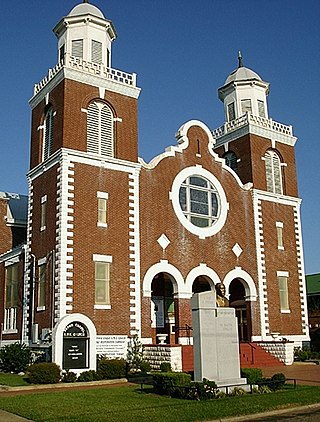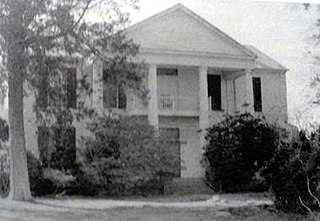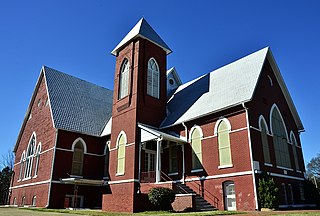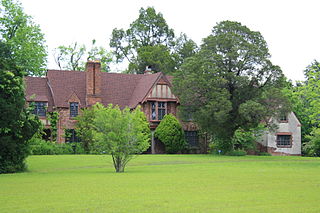
Fort Morgan is a historic masonry pentagonal bastion fort at the mouth of Mobile Bay, Alabama, United States. Named for American Revolutionary War hero Daniel Morgan, it was built on the site of the earlier Fort Bowyer, an earthen and stockade-type fortification involved in the final land battles of the War of 1812. Construction was completed in 1834, and it received its first garrison in March of the same year.

Cahaba, also spelled Cahawba, was the first permanent state capital of Alabama from 1820 to 1825, and the county seat of Dallas County, Alabama until 1866. Located at the confluence of the Alabama and Cahaba rivers, it suffered regular seasonal flooding.

Brown Chapel A.M.E. Church is a church at 410 Martin Luther King Jr. Boulevard in Selma, Alabama, United States. This church was a starting point for the Selma to Montgomery marches in 1965 and, as the meeting place and offices of the Southern Christian Leadership Conference (SCLC) during the Selma Movement, played a major role in the events that led to the adoption of the Voting Rights Act of 1965. The nation's reaction to Selma's "Bloody Sunday" march is widely credited with making the passage of the Voting Rights Act politically viable in the United States Congress.

Allen Grove is a plantation house and historic district located in Old Spring Hill, Alabama. The Greek Revival house was built for John Gray Allen in 1857 by David Rudisill. It is a two-story frame structure with a two-story front portico featuring square paneled columns. The roof is hipped with side dormers. In 1890 the rear facade was altered when a kitchen and pantry wing and a two-story back porch was added. The house and two other plantation buildings were added to the National Register of Historic Places on July 7, 1994, as a part of the Plantation Houses of the Alabama Canebrake and Their Associated Outbuildings Multiple Property Submission.

Cedar Haven was a historic Greek Revival plantation house located near Faunsdale, Alabama. It was built in 1850 by Phillip J. Weaver. Weaver was a prominent merchant and planter. He was born in Mifflintown, Pennsylvania in 1797 and relocated to Selma from Uniontown, Maryland in 1818. He ran a very successful store in Selma and also maintained a home there. Weaver was the paternal grandfather of the artist Clara Weaver Parrish.

The Dickinson House is a historic house in Grove Hill, Alabama. The two-story Italianate style house was built in 1845. It was designed by James Newman. It was added to the Alabama Register of Landmarks and Heritage on January 1, 1978, and to the National Register of Historic Places on September 13, 1978. The house was listed due to its architectural significance as an early example of Italianate architecture.

The Bush House is a historic house in Grove Hill, Alabama. The two-story Colonial Revival style house was built in 1912. It was added to the National Register of Historic Places on July 28, 1999. It was listed due to its architectural significance as a part of the Clark County Multiple Property Submission.

The Cobb House is a historic house near Grove Hill, Alabama. The two-story I-house was built in 1865. It was added to the Alabama Register of Landmarks and Heritage on January 29, 1980, and subsequently to the National Register of Historic Places on July 28, 1999. It was listed due to its architectural significance as a part of the Clarke County Multiple Property Submission.

The City of St. Jude is a 36-acre (15 ha) campus in Montgomery, Alabama, hosting a high school, hospital, and Catholic church, and was founded in 1934 by Fr Harold Purcell with the aim of bringing "light, hope and dignity to the poor," regardless of race.

The Joseph T. Smitherman Historic Building, also known by a variety of other names throughout its history, is a historic Greek Revival building in Selma, Alabama. Completed in 1847, it has served many functions in the more than 160 years of its existence. The building was added to the National Register of Historic Places on June 20, 1975, due to its architectural and historical significance. It currently houses the Vaughan-Smitherman Museum, a museum depicting Selma's history.

The Stone Plantation, also known as the Young Plantation and the Barton Warren Stone House, is a historic Greek Revival-style plantation house and one surviving outbuilding along the Old Selma Road on the outskirts of Montgomery, Alabama. It had been the site of a plantation complex, and prior to the American Civil War it was known for cotton production worked by enslaved people.

The John Tyler Morgan House is a historic Greek Revival-style house in Selma, Alabama, United States. It was built by Thomas R. Wetmore in 1859 and sold to John Tyler Morgan in 1865. Morgan was an attorney and former Confederate general. Beginning in 1876, he was elected as a Democratic U.S. senator from Alabama for six terms. He used this house as his primary residence for many of those years.

SS Selma was an oil tanker built in 1919 by F.F. Ley and Company, Mobile, Alabama. President Woodrow Wilson approved the construction of 24 concrete vessels of which only 12 were actually completed.

The 'Wesley Plattenburg House is a historic house in Selma, Alabama. Featuring a unique combination of the Greek Revival and Italianate styles, it was completed in 1842 for Wesley Plattenburg. Plattenburg was born on April 13, 1803, in Anne Arundel County, Maryland. He had relocated to Selma and had assumed the occupation of tailor by 1829. He became a successful merchant and served on the city council of Selma for many years.

First Baptist Church is a historic church at 709 Martin Luther King, Jr. Street in Selma, Alabama. A historically African American Baptist church, it was built in the Gothic Revival style in 1894 and known for its association with the Civil Rights Movement. It was added to the National Register of Historic Places in 1979.

The Driskell–Martin House is a historic house in Plantersville, Dallas County, Alabama. It is the oldest surviving high style residence in the community. The two-story wood-frame house was built for Thomas Sanford Driskell, a planter and a merchant from Virginia, in 1850. The builders were Nelson Mitchell and Massena Godwin. The house was used as a Union headquarters during the American Civil War. Their forces occupied it during Wilson's Raid through Alabama in April 1865. The house remained in the Driskell family until purchased by Dr. Thomas Munroe Martin in 1915.

Riverdale is a historic plantation house near Selma, Dallas County, Alabama. Architectural historians consider it to be the "most elegant and refined house of its period in Dallas County." The two-story wood-frame house was built in the Federal-style in 1829. It is five bays wide, with a two-tiered, pedimented portico spanning the central bay. It was built by Virgil H. Gardner, a native of Jones County, Georgia, for his bride, Margaret Loise Aylett of Virginia. Their daughter, Mary Gardner, was married in the house in 1854 to Henry Quitman, son of former Mississippi governor John A. Quitman.

The Marcus Meyer Skinner House, also known as the Howorth House, is a historic house in Selma, Dallas County, Alabama. The large two-story Tudor Revival-style house was built in 1928 for Marcus Meyer Skinner, a renowned surgeon and native of nearby Furman. It was designed by one of Alabama's leading architects of the day, Frank Lockwood.

The Old Town Historic District is a 323-acre (131 ha) historic district in Selma, Dallas County, Alabama. It is bounded by U.S. Route 80, Broad and Franklin streets, and Dallas and Selma avenues. The boundaries were increased on December 15, 2003. The district includes examples of the Federal, Greek Revival, Italianate, Gothic Revival, Victorian, Shotgun, Queen Anne, Romanesque Revival, Renaissance Revival, and Classical Revival. It contains 629 properties, with 513 contributing and 116 noncontributing to the district. It was added to the National Register of Historic Places on May 3, 1978.

Nowell-Mayerburg-Oliver House is a historic home located at Selma, Johnston County, North Carolina. It was built about 1912, and is a two-story, 2 1/2-bay, square, Queen Anne style frame dwelling. It features gabled projecting bays, a three-story octagonal stair tower, second story Palladian window, and a wrap-around porch with elegant Ionic order columns. Also on the property are the contributing garage and a small bungalow style summer house.





















